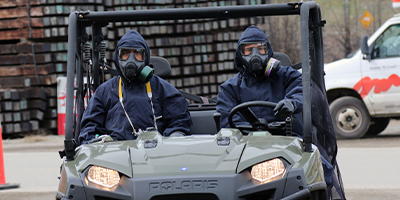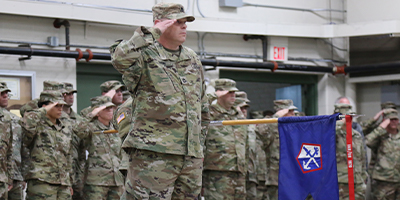
The specific mission of the 13th WMD-CST is to, on order, deploy by air, ground or sea to a suspected or known WMD incident involving CBRNE agents. Support civil authorities at an incident site by providing presumptive field analysis of CBRNE agents and/or unknown substances in support of a life-safety nexus; assess current and projected consequences, advise on response measures, and assist with requests for additional DOD and state support.
The 13th WMD-CST consists of 22 personnel that deploy in support of emergency preparedness programs to prepare for or to respond to any emergency involving:
(1) the use or threatened use of a weapon of mass destruction in the United States;
(2) a terrorist attack or threatened terrorist attack in the United States that results, or could result, in catastrophic loss of life or property;
(3) the intentional or unintentional release of nuclear, biological, radiological, or toxic or poisonous chemical materials in the United States that results, or could result, in catastrophic loss of life or property; or
(4) a natural or manmade disaster in the United States that results, or could result, in catastrophic loss of life or property.
Key among the 13th CST’s equipment capabilities is the Analytical Laboratory System (ALS), an ISO accredited mobile lab platform, the Unified Command Suite (UCS), the primary communications platform to facilitate reach back for both the unit and the supported organizations. Additionally, the Survey section has a wide array of highly specialized detection equipment with vast libraries and thresholds that can measure parts per million (ppm) and parts per billion (ppb) concentration. Unit member certifications include: Hazardous Materials Technician, Hazardous Waste Operations and Emergency Response (HAZWOPER), clandestine laboratory certification, Medical personnel licensing, etc. The unit is evaluated and assessed regularly to ensure it is aligned with all military, state, and federal regulations.

The mission of the Counterdrug Support Program (CD) is to coordinate and provide unique military skills, and resources to support Law Enforcement Agencies (LEA) and Community Based Organizations in their efforts to disrupt and dismantle various aspects of the illicit markets supporting the drug and narcotic trade.
In State the Counter-Drug Program provides support to five law enforcement agencies with embedded criminal intelligence analysts; the local offices of the Drug Enforcement Administration, the US Postal Inspector Service, the Food and Drug Administration Office of Criminal Investigations,the Rhode Island State Police Narcotics (HIDTAInitiative) and Financial Crimes Units, and the Providence Police Department.

The Joint Force Headquarters (JFHQ-RI), exercises command and control of all assigned, attached or operationally aligned forces within the geographical boundaries of the state. JFHQ-RI is organized and manned to respond to the challenge spresented in the post 9/11 environment to include the ability to coordinate an effective and timely response to Homeland Defense, Defense Support to Civil Authorities, and other domestic emergency missions. All units of the RI Air and Army National Guard are available for emergency response. Additionally, National Guard assets from other states or Title 10 (Active) forces maybe deployed and fall under the command and control of JFHQ-RI with concurrence of their Governor or President, respectively. A Joint Staff consisting of a Chief of Staff and eight directors assist the Commander, JFHQ-RI with mission execution.
